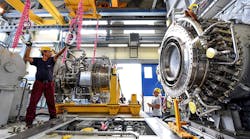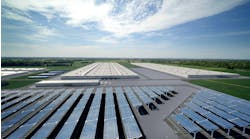Rhode Island -- Bringing Back Glory Days of Manufacturing
Rhode Island first appeared on the manufacturing map back in 1793 when the Slater Mill created the first cotton-spinning factory in the U.S. That event branded Rhode Island as the birthplace of the American Industrial Revolution.
In the years since the state has continued building its manufacturing expertise. The state is well- known for its jewelry making, with over 1000 companies currently active in this sector. And large companies such GE and General Dynamic (Electric Boat division) and Johnson & Johnson have facilities in the state.
However, like all states, adverse economics have taken a toll. Companies have left and jobs have been lost.
But that’s not sapping this state’s strength. It has been trying and has succeeded, in bringing back the previous glory.
“We were a pioneer in manufacturing,” explains Secretary of Commerce Stefan Pryor, “and many of our companies have held on through thick and thin. We are doing what needs to be done and have seen growth in manufacturing in 2016.”
In fact, April was a banner month for employment in manufacturing as the state added 900 jobs.
Overall 2016 was a good year for the state. One of the big wins last year was when General Electric opened its Digital information technology center. The new office, which will develop software applications, will bring hundreds of new jobs over the next few years.
Strategic Planning
Attracting jobs either through expansion of existing companies or bringing in new companies is exactly the outcome that Governor Gina M. Raimondo had in mind when she introduced the Rhode Island Manufacturing Initiative in 2015.
The plan is a comprehensive package of new programs designed to help train Rhode Islanders to compete in modern manufacturing and provide assistance to local manufacturers looking to buy new equipment or hire more workers.
The plan also focuses on spurring growth in a variety of sectors, including high-value “advanced industry” clusters. When the state was trying to determine which sectors to concentrate on, they brought in the Brookings Institute to analyze both current and future strengths. The report concluded that looking at value added per workers clusters such Defense Shipbuilding and Maritime; Design, Materials, Food, and Custom Manufacturing, Rhode Island exceeded national levels.
Looking at sectors with high job growth, Brookings identified the broad cluster of Marine, Materials, and Machinery, which encompasses the manufacturing components of the Defense Shipbuilding and Maritime. This cluster has held strong through the economic recovery, growing 9.1% in Rhode Island compared to 4.9% nationally. It is also quite sizable at over 19,000 jobs.
Making sure the talent pipeline is available for future growth, the state has invested in a variety of programs. Some include:
• The Rhode Island's Promise free college proposal which will guarantee every Rhode Island student an opportunity earn an associate's degree from Community College of Rhode Island or attend University of Rhode Island or Rhode Island College tuition free their junior and senior year
• Job-ready Workplace Learning Program to provide refundable job training tax credits on a competitive basis to help support job training
• Pathways in Technology Early College High School (P-TECH) initiative to continue the manufacturing training partnership at Westerly High School and potentially create another partnership related to manufacturing
"We needed a place that had a strong tech talent pipeline, top-tier university partnership opportunities and great quality of life," Chris Drumgoole, vice president and chief technology officer for GE said when announcing the company’s new center last year. "With its unique location along the northeast corridor, Rhode Island gives us access to many of the assets we need for success."
Other programs supporting the sector include an expansion of the Qualified Jobs initiative to include manufacturing companies. A program called Real Jobs RI helped train hundreds of workers for manufacturing jobs at Electric Boat, among others.
“We are going all out to ensure that our students view manufacturing as a viable career choice,” says Pryor. “We have one of the most unique programs across the country called the Wavemaker Fellowship which provides a financial incentive for graduates pursuing a career or starting a business in Rhode Island in technology, engineering, design and other key sectors, by defraying student loan payments for up to four years.”
Building Innovation
A key to attracting both workers and companies is innovation. The state is active in this area as well. It created an Innovation Voucher program dedicated to supporting manufacturers' in-house research and development. The program provides companies with fewer than 500 employees grants of up to $50,000 to fund R&D assistance from a Rhode Island university, research center or medical center.
Another major project is a type of Innovation Campus to help entrepreneurs scale up and bring ideas to prototype and eventually to market. Starting this year The Rhode Island Commerce Corporation, in partnership with the University of Rhode Island, began requesting proposals from industry, academic and research partners to develop, program and occupy the Innovation Campus.
The state already has a strong foothold in research with universities conducting over $320 million in research each year. The 30% growth in the state’s research activity is double the national rate of 16%.
Innovation is also driving further development of the state's Quonset Business Park which currently houses 200 companies and employs 11,000.
“The success of Quonset continues to be a factor in the growth of manufacturing,” explains Pryor. He cites Finlay Extracts & Ingredients USA as a perfect example. The company is building a $17-million research and development facility at Quonset. When the facility is finished it will be a $100 million investment bringing in 500 new jobs.
The company was also provided an incentive package from the state’s Commerce Corp., giving the company $1.35 million in cumulative credits over 10 years for having construction jobs that have an annual average salary of $56,056 and $572,000 in tax credits as part of Rebuild Rhode Island.
Another physical location for innovation is underway as well. A $610 million project is in place to realign the intersection of Interstates 95 and 195 in Providence freed up space and linked the city’s Jewelry District with downtown. Rhode Island created the I-195 Redevelopment Fund to lure the technology, medical and higher education industries to the newly created neighborhood. The potential anchors of the area are Brown University, The University of Rhode Island and the Cambridge Innovation Center.
The simultaneous activity in providing a variety of incentives and new physical location for manufacturing is catching the attention of site selectors. The Boyd Co., a site selection company based in New Jersey, recently studied the area and analyzed the costs of operating a hypothetical 225,000-square-foot advanced manufacturing plant employing 500 people. Rhode Island ranked better than New York, New Jersey and much of New England.
“For the first time in a long time, I would identify Rhode Island as an exciting place for new speculative building,” Principal John Boyd Jr., said while in Rhode Island visiting executives.




